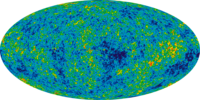
Photo from wikipedia
Author(s): Derenzo, S; Essig, R; Massari, A; Soto, A; Yu, TT | Abstract: © 2017 American Physical Society. We suggest a novel experimental concept for detecting MeV-to-GeV-mass dark matter, in… Click to show full abstract
Author(s): Derenzo, S; Essig, R; Massari, A; Soto, A; Yu, TT | Abstract: © 2017 American Physical Society. We suggest a novel experimental concept for detecting MeV-to-GeV-mass dark matter, in which the dark matter scatters off electrons in a scintillating target and produces a signal of one or a few photons. New large-area photodetectors are needed to measure the photon signal with negligible dark counts, which could be constructed from transition edge sensor (TES) or microwave kinetic inductance detector (MKID) technology. Alternatively, detecting two photons in coincidence may allow the use of conventional photodetectors like photomultiplier tubes. We describe why scintillators may have distinct advantages over other experiments searching for a low ionization signal from sub-GeV dark matter, as there are fewer potential sources of spurious backgrounds. We discuss various target choices, but focus on calculating the expected dark matter-electron scattering rates in three scintillating crystals: sodium iodide (NaI), cesium iodide (CsI), and gallium arsenide (GaAs). Among these, GaAs has the lowest band gap (1.52 eV) compared to NaI (5.9 eV) or CsI (6.4 eV), which in principle allows it to probe dark matter masses as low as ∼0.5 MeV, compared to ∼1.5 MeV with NaI or CsI. We compare these scattering rates with those expected in silicon (Si) and germanium (Ge). The proposed experimental concept presents an important complementary path to existing efforts, and its potential advantages may make it the most sensitive direct-detection probe of dark matter down to MeV masses.
Journal Title: Physical Review D
Year Published: 2017
Link to full text (if available)
Share on Social Media: Sign Up to like & get
recommendations!